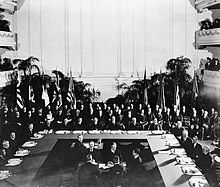Five-Power Treaty
| Limitation of Naval Armament | |
|---|---|

Signing of the Washington Naval Treaty.
|
|
| Type | Arms control |
| Context | World War I |
| Signed | February 6, 1922 |
| Location | Memorial Continental Hall, Washington, D.C. |
| Effective | August 17, 1923 |
| Expiration | December 31, 1936 |
| Negotiators | |
| Signatories | |
| Parties | |
| Language | English |
|
|
|
The Washington Naval Treaty, also known as the Five-Power Treaty, the Four-Power Treaty, and the Nine-Power Treaty, was a treaty among the major nations that had won World War I, which agreed to prevent an arms race by limiting naval construction. It was negotiated at the Washington Naval Conference, held in Washington, D.C., from November 1921 to February 1922, and it was signed by the governments of the United Kingdom, the United States, Japan, France, and Italy. It limited the construction of battleships, battlecruisers and aircraft carriers by the signatories. The numbers of other categories of warships, including cruisers, destroyers and submarines, were not limited by the treaty, but those ships were limited to 10,000 tons displacement.
The naval treaty was concluded on February 6, 1922. Ratifications of that treaty were exchanged in Washington on August 17, 1923, and it was registered in League of Nations Treaty Series on April 16, 1924.
Later naval arms limitation conferences sought additional limitations of warship building. The terms of the Washington treaty were modified by the London Naval Treaty of 1930 and the Second London Naval Treaty of 1936. By the mid-1930s, Japan and Italy renounced the treaties, making naval arms limitation an increasingly untenable position for the other signatories.
Immediately after World War I, the United Kingdom had the world's largest and most powerful navy, followed by the United States and more distantly by Japan. The three nations had been allied for World War I, but a naval arms race seemed likely for the next few years. President Woodrow Wilson's administration had already announced successive plans for the expansion of the US Navy from 1916 to 1919 that would have resulted in a massive fleet of 50 modern battleships. At the time, it was engaged in building six battleships and six battlecruisers.
...
Wikipedia
